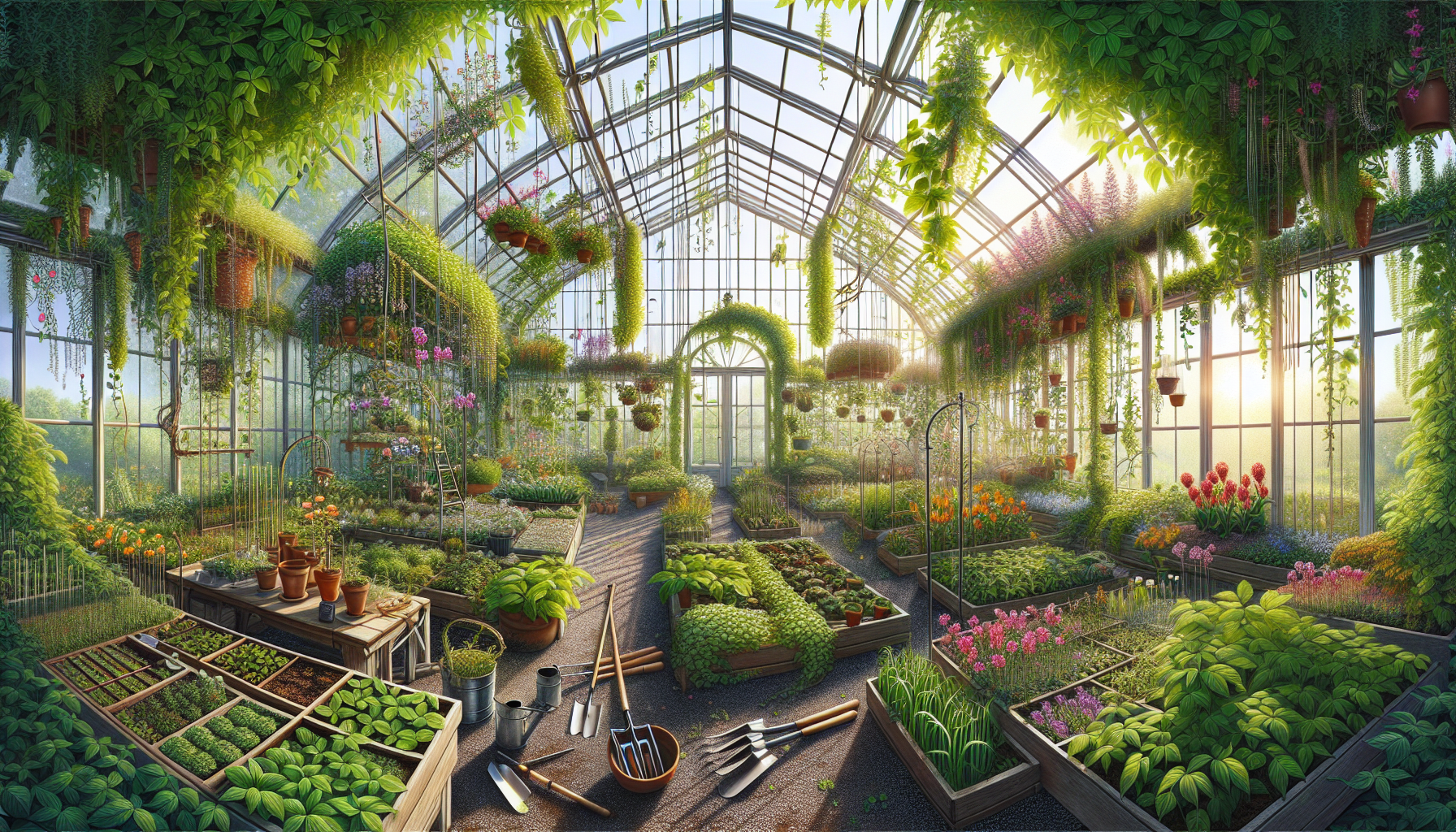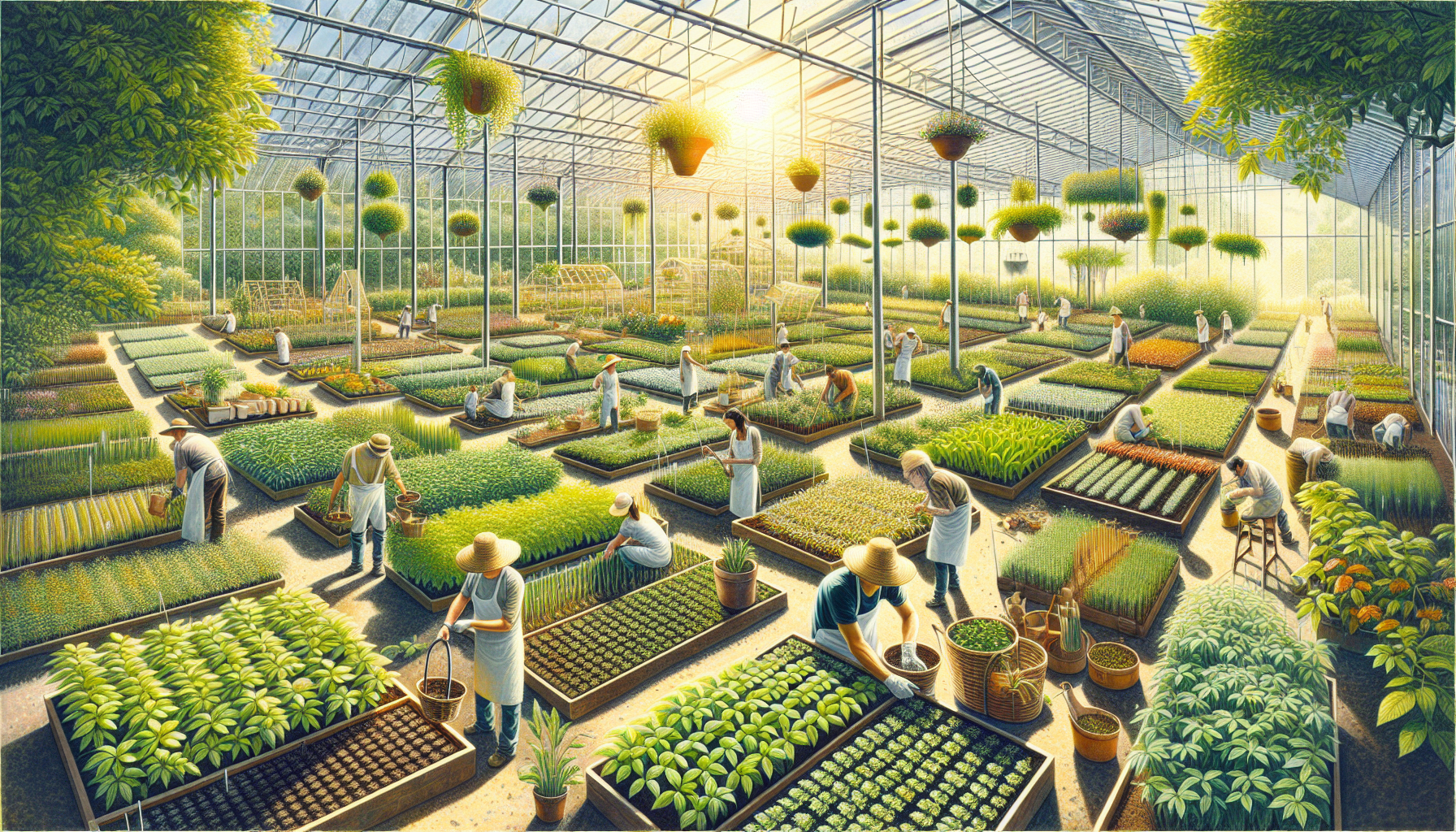
You’re about to embark on an exciting journey through “The Ultimate Greenhouse Gardening Calendar,” a comprehensive guide that’s brimming with valuable information at your fingertips. Designed to add a touch of clarity and convenience to your green thumb endeavors, this calendar will be your trusty companion throughout the year, keeping you updated on when to plant, nurture, and harvest your favorite fruits, vegetables, and herbs. It’s tailored for both the novice and seasoned gardeners aiming to maximise their greenhouse potential. Your passion for gardening, combined with this tool, is set to blossom a fruitful and enjoyable gardening experience all year long.

Understanding the Greenhouse Environment
Greenhouse gardening, as you may already know, demands a deep understanding of the unique conditions and microclimates within a greenhouse. By thoroughly understanding the environment inside your growing space, you can create optimal conditions for your plants to flourish.
The Microclimates of a Greenhouse
Different areas inside your greenhouse can have distinct climates, known as microclimates. For instance, temperatures near the roof may be hotter due to rising heat, while areas near the ground may be cooler. Monitor these microclimates so you can strategically place different plants based on their temperature and humidity preferences.
Monitoring Temperature and Humidity
Maintaining ideal temperature and humidity levels in your greenhouse is key. Regular monitoring using thermometers and humidity gauges will ensure your plants have the right atmosphere to thrive. From heat-loving tomatoes to moisture-loving ferns, monitoring can help cater to each plant’s needs.
Lighting Needs Throughout the Year
Depending on the time of year, plants will require varying amounts of light. In the winter months, you may need to supplement natural light with artificial options, such as grow lamps, to ensure your plants receive the necessary intensity of light.
Ventilation and Air Circulation Importance
Ventilation is another crucial factor in greenhouse management. Proper air circulation prevents the buildup of stale air, reduces the spread of diseases, and assists in pollination. While opening doors and windows can provide ventilation, mechanical options like exhaust fans may be necessary in larger greenhouses.
Greenhouse Gardening Basics
Venturing into greenhouse gardening needs an understanding of some basics like the essential tools, soil maintenance, watering systems, and knowledge of fertilizers.
Tools and Equipment Essentials
The correct tools can simplify your greenhouse tasks and promote healthier growth. Essentials include pruning shears for trimming, trowels for digging, and watering cans or hoses for irrigation. Consider investing in automated systems like temperature or humidity controllers for larger greenhouses.
Soil Preparation and Maintenance
A good start begins with preparing the soil. Add organic matter and test the pH level to ensure it is ideal for your chosen plants’ growth. Regularly adding compost and rotating crops can help maintain soil vitality.
Watering Systems and Schedules
Plants need water, and managing moisture in a greenhouse is critical. Whether you opt for hand watering or an automated drip irrigation setup, your system should provide consistent, adequate water. Remember, overwatering can be just as harmful as underwatering.
Understanding Fertilizers and Plant Nutrition
Plants require numerous nutrients to grow. While some are readily available in the soil, others need supplementation via fertilizers. Understanding your plants’ unique nutritional needs is crucial to choosing the right fertilizer.
Spring Calendar
Spring is an exciting season in the greenhouse. Activities typically include starting seedlings, adjusting temperature and ventilation, and managing pests and diseases.
Starting Seedlings
Spring is the time to germinate seedlings for summer crops. Use a seed starting mix and keep the environment moist and warm. Once the seedlings develop a few sets of true leaves, they are ready for transplanting.
Transplanting and Spacing
When transplanting your seedlings, place them into larger pots or into your greenhouse beds. Ensure that the plants are spaced adequately to allow for optimal growth and to avoid crowding that can lead to the spread of disease.
Ventilation and Temperature Adjustments
With the warming weather, adjustments to ventilation and temperature may be necessary. Monitor the microclimate conditions in your greenhouse and adjust accordingly.
Pest and Disease Management
With the arrival of spring, pests awaken, and diseases can become rampant. Regular inspection of your plants and the introduction of preventative measures can help keep potential threats at bay.
Summer Calendar
Summertime in the greenhouse is primarily about managing heat, optimizing sunlight exposure, and ensuring effective pollination.
Maximizing Sunlight Exposure
During summer, there’s an abundance of natural light. Rearrange your plants if necessary to make sure they all get the sunshine they need.
Heat Stress Prevention
Despite the need for sunlight, too much heat can stress plants and may lead to wilting or sunburn. Ensure your greenhouse is well ventilated and consider using shade cloths during the peak heat of the day.
Pollination and Plant Support
In summer, many plants will start to flower. Some may need help with pollination, which can be done by gently shaking the plants or using a small brush. Others may need staking or trellising for support as they develop heavy fruits.
Harvesting Tips and Techniques
Summer is also the time to reap the rewards of your hard work – the harvest. Remember, frequent harvesting encourages more growth, and different crops may require unique harvesting techniques.

Autumn Calendar
As autumn approaches, gardeners prepare for the colder weather, introduce cool-weather crops, and try to extend the growing season.
Preparing for Colder Weather
With the arrival of fall, you need to prepare your greenhouse for the colder months ahead. Check for drafts, insulate where necessary, and ensure your heating systems are working properly.
Introducing Cool-Weather Crops
Autumn is the season for cool-weather crops like spinach and lettuce. These crops can tolerate lower temperatures and give you a bountiful fall harvest.
Extending the Growing Season
By maintaining a warm and conducive environment, you can extend the growing season of your summer crops well into the cooler months.
Cleaning and Maintenance Pre-Winter
Before winter sets in, it’s time to clean your greenhouse thoroughly and conduct any necessary maintenance or repairs.
Winter Calendar
Winter can be a challenging time for greenhouse gardening. Managing insulation, lighting, and water during these cold months are crucial.
Insulation and Heating
Proper insulation and adequate heating can ensure your plants survive the winter. Bubble wrap can add an extra layer of insulation to your greenhouse, while heating solutions can range from gas heaters to heated propagation mats.
Lighting Adjustments for Shorter Days
During winter’s shorter days and longer nights, additional lighting may be necessary. Grow lamps can help supplement natural light and provide your plants with the light they need for photosynthesis.
Growing Cold-Tolerant Varieties
Opting for cold-tolerant varieties can be beneficial in winter. Plants like kale and broccoli not only thrive in cool conditions, but they can also add some much-needed greenery to your winter greenhouse.
Water Management During Cold Months
Watering dynamics change during winter. Plant’s metabolism slows down in cooler temperatures, reducing their need for water. Also, excess water can freeze, causing root damage. Modify your watering schedule accordingly to prevent overwatering.
Year-Round Crop Planning
Effective year-round crop planning requires understanding the concepts of crop rotation, succession planting, companion planting, and the care of perennial plants.
Rotating Crops for Health and Yield
Crop rotation helps prevent the build-up of pests and diseases and maintains soil health. By changing the type of crops grown in specific areas each season, you can naturally manage your greenhouse environment.
Succession Planting
With succession planting, as soon as one crop is harvested, another is immediately planted in its place. This technique maximizes the use of your greenhouse space and often allows for multiple harvests within a growing season.
Companion Planting in the Greenhouse
Companion planting involves grouping plants that work well together – either by deterring pests, enhancing growth, or optimizing space. This can create a more harmonious and productive greenhouse environment.
Perennial Plants and Year-Round Care
Perennial plants are those that live for more than two years. They can provide a continuous presence in your greenhouse, and understanding their specific care requirements will ensure their healthy growth year-round.
Pest Control and Management
Effective pest control in a greenhouse involves identifying common pests, using organic control methods, introducing beneficial insects, prevention, and regular monitoring.
Identifying Common Greenhouse Pests
Common greenhouse pests include aphids, whiteflies, spider mites, and mealybugs. Being able to accurately identify these pests is the first step to effective pest management.
Organic Pest Control Methods
You might prefer to choose organic pest control methods that are safe for both you and the environment. Options include insecticidal soaps, diatomaceous earth, neem oil, and homemade sprays.
Beneficial Insects and Biological Controls
Beneficial insects, like ladybugs, lacewings and predatory mites, can be introduced to control pest populations. Biological controls, such as bacteria, fungi, or nematodes, can also be effective in managing pests.
Regular Monitoring and Preventive Measures
Regular inspection of your plants and preventive measures, like installing yellow sticky traps or integrating pest-resistant varieties, can also help keep pests under control.
Greenhouse Maintenance Routines
Maintaining cleanliness, conducting regular inspections, taking care of tools, and rejuvenating the soil can help in ensuring a healthy greenhouse environment.
Monthly Cleaning and Disinfecting
Regular cleaning and disinfecting of your greenhouse reduce the risk of pests and diseases, promotes better sunlight penetration, and generally provides a healthy environment for plant growth.
Structural Inspections and Repairs
Keep an eye on your greenhouse structure. Look for any signs of damage or wear and tear regularly and promptly conduct necessary repairs.
Equipment and Tool Upkeep
Don’t neglect your equipment and tools. Regular cleaning, sharpening, and proper storage can extend their lifespan and effectiveness.
Soil and Substrate Rejuvenation
Over time, nutrients in the soil may get depleted. Regular rejuvenation with compost or organic matter can keep your soil fertile and ready for healthy plant growth.
Monthly Checklists and Schedules
Developing a personalized monthly checklist and schedule can help you stay organized, ensuring no gardening task is forgotten.
Creating a Custom Greenhouse Gardening Calendar
A custom greenhouse gardening calendar can record your planting cycles, pest control measures, and maintenance routines organized and serves as a useful tool for planning year-round activities.
Month-to-Month Task Lists
A task list provides a quick and easy reference for what needs to be done every month. Whether it’s seed starting in spring or fall cleanup, a task list can keep you on track.
Daily Routines for Consistent Results
Having a regular daily routine, such as morning watering or evening temperature checks, can lead to consistent and successful results in your greenhouse.
Seasonal Reviews and Planning for the Next Year
At the end of every season, take time to review what has worked well, what has presented challenges, and plan for the upcoming year. Continuous learning is key to a productive and rewarding greenhouse gardening experience.

